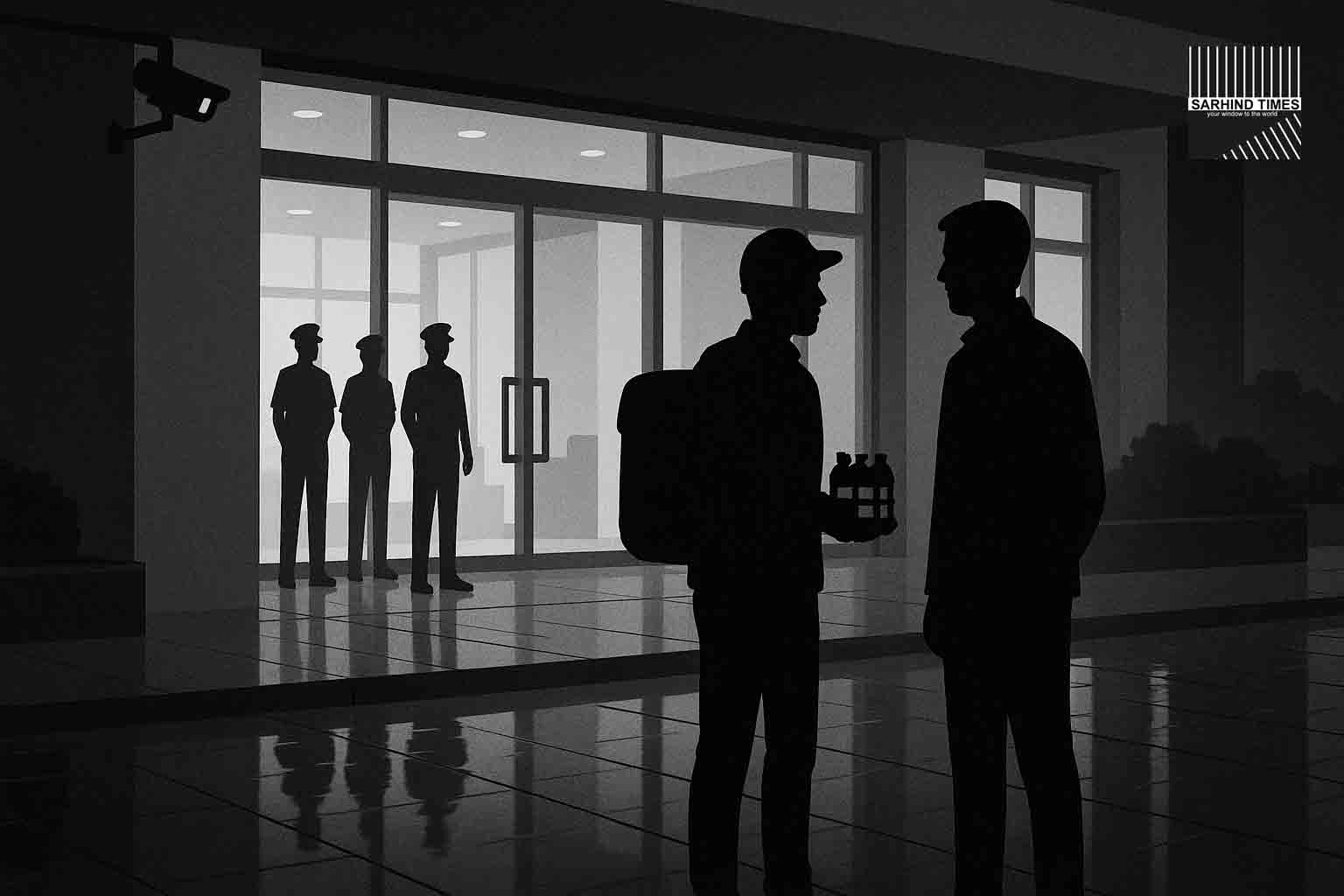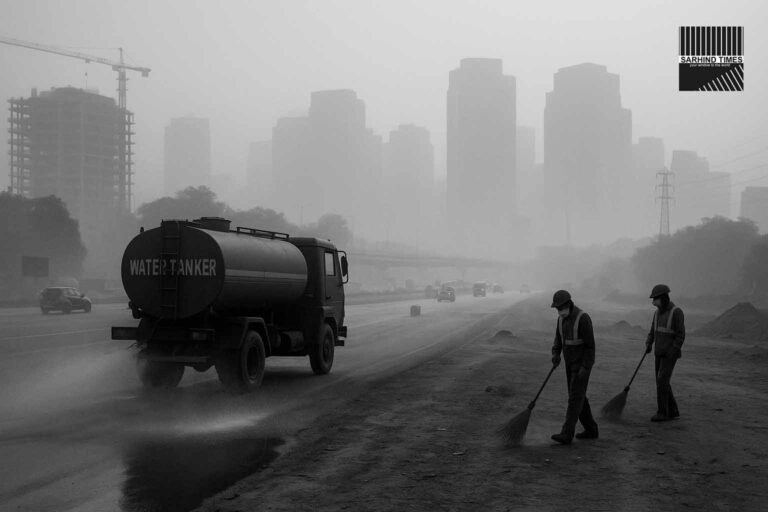By SarhindTimes City Desk | Gurugram
Date: October 8, 2025
A weekend scuffle at Element One Mall in Sector 47, Gurugram has triggered a police probe and a wider debate on delivery-partner access to gated complexes and mixed-use developments. A businessman and a delivery agent were allegedly assaulted by hotel staffers after a bottle of water ordered via a food-delivery app reached the premises around 8 PM on Saturday. Police said a case has been registered under relevant provisions of the Bharatiya Nyay Sanhita (BNS) and CCTV footage is being examined.
The incident: What complaint says, what police are checking
According to the complaint cited in early reports, the customer—identified as Amit Kumar Mishra—had ordered a bottle of water on a food-delivery platform. When the delivery worker was allegedly stopped from entering the residential section of the mixed-use complex, the customer came down to escort him, after which a confrontation broke out. Both the customer and the delivery agent were allegedly attacked by members of the hotel staff near the ground floor. The customer reported injuries and sought medical attention. Police said statements are being recorded and CCTV footage from the mall is being reviewed to establish the sequence of events and each individual’s role. An FIR has been registered for offences pertaining to voluntarily causing hurt, wrongful restraint, and criminal intimidation under the BNS.
Officers added that further legal action will hinge on medical reports and video evidence. The police also noted the layout of Element One Mall—which houses both commercial and residential sections—can create confusion over access routes for third-party personnel such as delivery executives, housekeeping staff, technicians, and guests, particularly in evening hours.
Mixed-use design, mixed signals: How access ambiguities escalate
Element One is among Gurugram’s many mixed-use properties where retail, hospitality, and residential spaces co-exist. During peak hours, delivery partners often navigate multiple check-posts—mall security, tower-specific gates, and sometimes hotel lobbies used as thoroughfares. In the absence of standard operating procedures (SOPs) and clear signage, friction can arise around where a delivery person may wait, who authorizes entry, and whether building residents can escort couriers past controlled zones. Saturday’s clash appears to have occurred in this grey zone of responsibility and protocol. (Context from incident description; core facts per cited report.)
Security managers typically cite concerns ranging from crowd control, asset safety, and guest experience to compliance with fire-safety and insurer requirements. Delivery platforms, on the other hand, argue that timely, safe access is a basic expectation residents pay for when ordering essentials, and that partners should not be subjected to arbitrary denials or confrontation at checkpoints. (Context/industry practice; incident facts per cited report.)
The law: What the BNS covers in such situations
While a final legal determination awaits the investigation, the Bharatiya Nyay Sanhita provisions invoked by police—voluntarily causing hurt, wrongful restraint, criminal intimidation—are the standard legal pathways used when physical altercations are alleged and preliminary evidence suggests force, blocking of movement, and threats. Police regularly rely on medical-legal certificates (MLCs), CCTV footage, and eyewitness statements to decide on further sections and arrests. In premises disputes, investigators also look at property by-laws, tenancy rules, and facility SOPs to see whether any party exceeded lawful authority or ignored posted instructions. (General legal context; case specifics per FIR reference.)
Witness accounts & early responses
Residents in and around Sector 47 told SarhindTimes that evening deliveries in mixed-use corridors often face delays because guards are unsure who authorizes entry. “Some towers insist the resident must come down; others allow entry after a call. If the lobby is part of a hotel, staff sometimes object to couriers walking through,” said a resident who requested anonymity. (Local color; not attributing to official sources.)
From the gig-worker community, early reactions emphasized the need for a single-window protocol at such complexes: designated waiting bays, QR-based check-ins, and time-bound authorization—so couriers don’t wander between hotel desks, mall counters, and tower gates, risking confrontation.
The platform side tends to highlight that delivery partners are trained to follow building rules and escalate to support in case of disputes—but also expects premises managers to avoid blanket restrictions that put workers at risk. (General industry practice context.)
What CCTV can (and can’t) tell investigators
CCTV rarely captures every angle of a dynamic scuffle. Investigators will map camera coverage—mall entrance, hotel lobby or corridor, lift lobbies, exit doors—and reconstruct movements with timestamps. They will also sync footage with call logs (to guards, reception, or residents), access cards, and boom-barrier data if available. In mixed-use properties, managements sometimes maintain separate CCTV systems for retail, hospitality, and residential associations. Obtaining all feeds is essential to build a continuous chain. (Process context; case facts per cited report.)
Safety at work: Why access clarity matters for delivery partners
India’s booming on-demand economy has made delivery partners a ubiquitous presence in cities. But access rules still vary widely. In many places, couriers are told to wait at the main gate—even if the property spans several acres—requiring residents to walk down or send domestic help to collect items. Tensions rise when confusing rules collide with service-level expectations (e.g., “door-step delivery” vs “gate-pickup”). Doorstep promises fuel customer expectations; premises restrictions limit what couriers can legally do.
Worker groups argue that predictable, humane rules reduce flashpoints:
- Clearly marked pick-up/hand-off points inside premises.
- Priority lanes/time windows for quick in-and-out movement during peak hours.
- Emergency helpline signage at gates, so partners can quickly alert facility managers or police if a situation escalates.
- Zero-tolerance for physical intimidation—paired with penalties for rule-breaking couriers (e.g., entering restricted lifts or resident-only areas without authorization).
For building managers: Five SOPs that reduce conflict
- Unify entry protocols across all gates/towers and publish them on a notice board and website.
- Create a QR or OTP-based system: the resident authorizes entry digitally; the guard sees a time-bound pass.
- Mark a delivery corridor (or waiting bay) with CCTV and public lighting to ensure safe, visible hand-offs.
- Train hotel/front-office staff posted at shared lobbies on residential access rules to avoid ad-hoc refusals.
- Maintain an incident log and a redress window (RWA + facility + vendor liaison) to resolve complaints quickly.
For platforms: Three immediate improvements
- Pre-arrival messaging to residents: “Your courier will reach Gate X in 3 minutes; premises policy requires pickup here.”
- In-app reporting that flags “premises-policy conflict,” routing cases to a dedicated facilities liaison team.
- Geo-fencing that nudges couriers to the approved hand-off point and warns if they drift into restricted zones.
For residents: Know your rights—and responsibilities
- You can insist on safe, non-harassing treatment of anyone you invite (including delivery partners), subject to lawful property rules.
- If a facility requires gate pickup, plan accordingly to avoid last-minute flare-ups.
- If you witness a confrontation, do not intervene physically. Record short video only if safe, call the security supervisor and, if needed, 100/112.
The bigger picture: Why this case matters
Saturday’s incident isn’t just about one mall or one hotel front desk. It reflects a rapidly changing urban India where digital services interact with old-world premises controls. When SOPs lag demand, conflicts increase—hurting workers, inconveniencing residents, and exposing facilities to legal and reputational risks.
Cities like Gurugram—with a high concentration of mixed-use complexes—need city-level templates for delivery access: from signage standards and common iconography (so every gate looks familiar), to data-sharing frameworks between platforms and RWAs for temporary digital passes. Done right, such frameworks reduce guard-resident friction, streamline courier movement, and minimize crowding in lobbies.
Police investigation: What happens next
In the days ahead, expect investigators to:
- Retrieve and analyze CCTV from multiple nodes at Element One.
- Record statements of the complainant, delivery partner, hotel staff, guards, and any eyewitnesses.
- Examine duty rosters and internal communication among staffers present at the time.
- Correlate injuries with alleged assault via medical-legal certificates.
- Decide on arrests/summons depending on corroboration and roles. (Investigation flow; case facts per FIR reference.)
Police also indicated that the mixed-use nature of the complex—residential plus hospitality/retail—will be a factor in understanding who had authority to give or deny access, and whether any staff exceeded that authority.
What facilities can do now—before the next flashpoint
Even as the case proceeds, facilities across NCR can act:
- Audit gate flow during peak hours; identify choke points where couriers are most frequently turned back.
- Assign a delivery coordinator during 6–10 PM to handle high-volume windows.
- Publish a simple map (Gate A → Lift B → Hand-off Point) and share it with residents via WhatsApp/notice boards.
- Run a two-week pilot with a nearby platform to test QR-entry for prepaid, low-risk items (e.g., water, groceries).
- Escalation ladder: guard → supervisor → facility manager → RWA hotline. Avoid spontaneous confrontations at the gate.
Editorial view: Order with dignity
Public order in private spaces depends on clear rules, humane conduct, and prompt redress. Delivery partners keep the city’s households running—from midnight medicines to bottled water after a long day. Facilities have legitimate safety obligations. The answer lies in predictability, not gatekeeping by confrontation.
Saturday’s case should be the moment Gurugram’s mixed-use complexes adopt uniform signage, time-bound authorizations, and non-negotiable anti-violence norms. We owe workers a safe shift, residents a smooth service, and staff a process that keeps everyone out of harm’s way. (Opinion clearly labelled)
#Gurgaon #Sector47 #LawAndOrder #GigEconomy #DeliveryPartners #MallSecurity #BNS #CCTV #Gurugram #ElementOne #SafetyAtWork #UrbanLiving #MixedUse #AccessPolicy #NCR
























+ There are no comments
Add yours